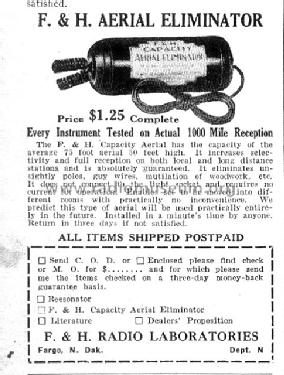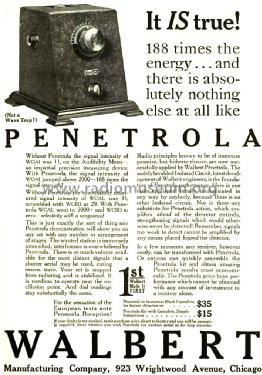LizzieMaine
Bartender
- Messages
- 33,715
- Location
- Where The Tourists Meet The Sea
In the Era, the back pages of popular magazines were filled with gimmicks and gadgets designed to augment or improve your radio listening experience. Many of them were ripoffs and swindles, but some of them did, indeed, work as advertised.
I recently picked up a gadget called the "F&H Capacity Aerial Eliminator."

I had been reading ads for this device for years, and was always intrigued by them. There were plenty of gadgets sold at the time which promised to "turn your house wiring into a giant antenna," and such devices are still sold today. I've tried those and none have worked particularly well. But the F&H ads always stress that this device is *not* one of these types of units, but rather an arrangement of capacitors which duplicates the capacity of a long-wire aerial. I don't have room to put up a proper outdoor antenna here -- my backyard is very small, and the trees I could use as anchor points are on the other side of the junkyard fence, and thus not accessible. So I've long wanted to give the F&H a try.
A few weeks ago I picked one up for cheap on eBay and last night after work I hooked it up to see what it could do. I have a Philco 37-10 console in the living room which I've had hooked up to about twenty feet of bare copper wire run along and around the baseboards. This has always given satisfactory local reception, but not much in the way of broadcast-band DX. I connected one wire of the F&H to the antenna terminal on the back of the set, one to the ground terminal, and then attached the ground wire of the F&H to my existing water-pipe ground wire. There is no connection to any current-carrying part of the set.
The results were very impressive. I got strong reception from about 700kc to the high end of the band, and got good volume on most of the clear-channel stations, with WCBS at 880kc and WINS at 1010kc coming in as loud and strong as locals. I picked up WBBM, Chicago at 780 kc -- not loud, but it was there, which exceeds the promise of "1000 mile reception" with mileage to spare. Daylight reception has also improved markedly -- where I got only weak reception of WBZ, Boston at 1030 kc during the day using the baseboard wire, the F&H brings it in with full, strong volume. There also seems to be a noticeable reduction in electrical noise -- I have a power-line transformer at the end of my driveway which buzzes to beat the band when it's damp or cold, and while there's still a buzz there, it's nowhere near as obtrusive as usual.
I'm very impressed with this gizmo, and plan to pick up a couple more of them for the radios in my office and my bedroom.
Who else has experimented with aerial eliminators, wave traps, subtennas, jim-dandy broadcast-thru-your-own-radio microphones, or other back-page radio gimcracks of the Era? What have your results been?
I recently picked up a gadget called the "F&H Capacity Aerial Eliminator."

I had been reading ads for this device for years, and was always intrigued by them. There were plenty of gadgets sold at the time which promised to "turn your house wiring into a giant antenna," and such devices are still sold today. I've tried those and none have worked particularly well. But the F&H ads always stress that this device is *not* one of these types of units, but rather an arrangement of capacitors which duplicates the capacity of a long-wire aerial. I don't have room to put up a proper outdoor antenna here -- my backyard is very small, and the trees I could use as anchor points are on the other side of the junkyard fence, and thus not accessible. So I've long wanted to give the F&H a try.
A few weeks ago I picked one up for cheap on eBay and last night after work I hooked it up to see what it could do. I have a Philco 37-10 console in the living room which I've had hooked up to about twenty feet of bare copper wire run along and around the baseboards. This has always given satisfactory local reception, but not much in the way of broadcast-band DX. I connected one wire of the F&H to the antenna terminal on the back of the set, one to the ground terminal, and then attached the ground wire of the F&H to my existing water-pipe ground wire. There is no connection to any current-carrying part of the set.
The results were very impressive. I got strong reception from about 700kc to the high end of the band, and got good volume on most of the clear-channel stations, with WCBS at 880kc and WINS at 1010kc coming in as loud and strong as locals. I picked up WBBM, Chicago at 780 kc -- not loud, but it was there, which exceeds the promise of "1000 mile reception" with mileage to spare. Daylight reception has also improved markedly -- where I got only weak reception of WBZ, Boston at 1030 kc during the day using the baseboard wire, the F&H brings it in with full, strong volume. There also seems to be a noticeable reduction in electrical noise -- I have a power-line transformer at the end of my driveway which buzzes to beat the band when it's damp or cold, and while there's still a buzz there, it's nowhere near as obtrusive as usual.
I'm very impressed with this gizmo, and plan to pick up a couple more of them for the radios in my office and my bedroom.
Who else has experimented with aerial eliminators, wave traps, subtennas, jim-dandy broadcast-thru-your-own-radio microphones, or other back-page radio gimcracks of the Era? What have your results been?



